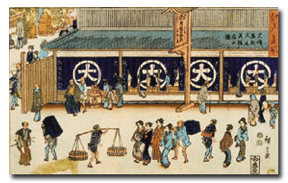今は物がありあまっています1。しかし、江戸時代には物があまりなかったので、人々は持っている物を大切に使いました。また、古くなったり、こわれた物はなんでも修理して2使ったので、ごみもあまり出ませんでした。江戸には、古い物やこわれた物を集めたり、修理したり、また売ったりする仕事がたくさんでき、すべて商売3として成り立っていました4。使い捨ての時代5に生きている6私達には、江戸時代の生活7からたくさん学べることがありそうです。



| Title | 江戸のリサイクル(1) Recycling in the Edo Era (1) |
| Unit/Lesson No. | Recycle/Lesson 7 |
| Topic | Lifestyle and garbage in the Edo Era |
| Function | Comparison, brainstorm |
| Focus | Learn the relationship between lifestyle and garbage in the Edo Era and compare them with current situations. |
Purpose of This Lesson
Students will learn about the relationship between lifestyle and the amount of garbage produced during the Edo Era. They will make comparison with current lifestyles and issues concerning garbage.
Teacher Instructions
Teacher Presentation Sample Scripts
Script 1
これは江戸時代の江戸の町の様子です。17世紀の江戸の人口はどのくらいだったと思いますか。(学生の答え:10万人?)江戸には、100万人の人が住んでいました。たくさん人が住んでいましたね。江戸の町には、ごみがたくさんあったと思いますか。ごみをどうしていたと思いますか。(学生の答え:うめた。もやした。)江戸時代の人はリサイクルをしていたと思いますか。(学生の答え:リサイクルをした。)ええ、江戸時代の人もごみをうめたり、燃やしたりしていました。それに、たくさんリサイクルもしていました。
Answer Key to Student Activities
1. a.リユース
2. No, because people in the Edo Era were using things carefully and even when those items became old or broken, they repaired and reused them.
3. (Answers may vary.) ex. a. e. f
4. ex. 冷蔵庫を修理して使っています。
Notes
Website sources:
江戸の回収専門業者
Leaning from Recycling during the Edo Period, WAHOO! Spring 2002
Visual resources:
Handout 1
Read the following paragraph and answer the questions.
|
今は物がありあまっています1。しかし、江戸時代には物があまりなかったので、人々は持っている物を大切に使いました。また、古くなったり、こわれた物はなんでも修理して2使ったので、ごみもあまり出ませんでした。江戸には、古い物やこわれた物を集めたり、修理したり、また売ったりする仕事がたくさんでき、すべて商売3として成り立っていました4。使い捨ての時代5に生きている6私達には、江戸時代の生活7からたくさん学べることがありそうです。
|
<Useful Vocabulary>
| 1. ありあまる = overabundant | 2. しゅうりする = to repair | 3. しょうばい = business |
| 4. としてなりたつ = to be realized as | 5. つかいすてのじだい = "throwaway" era | 6. いきる = to live |
| 7. せいかつ = life, lifestyle |
1. Which one of the "3Rs" were people exercising during the Edo Era?
a. リデュース b. リユース c. リサイクル
2. According to the passage, was there a lot of garbage produced during the Edo Era? Why or why not?
Yes / No
Reason(s): _____________________________________________________
_____________________________________________________
3. Work in pairs. The following are items which people in Edo repaired and reused. Circle the ones that people in contemporary society repair and reuse. Can you come up with any other items people repair and reuse?
| a. 着物 (服) | b. なべ | c. せともの |
|
|
|
|
| d. ほうき | e. ほうちょう | f. げた (くつ) |
|
|
|
|
| g. かさ | h. めがね | i. かぎ |
|
|
|
|
4. In groups of three, brainstorm and write down all the items you and your family repair and reuse, and why. Share the results with the class.
例: 車を修理して乗っています。新しい車を買うのはお金がかかるからです。
________________________________________________________________
________________________________________________________________
________________________________________________________________
________________________________________________________________
5. Discuss the following in groups of three or four.
At the end of the passage, it says “使い捨ての時代に生きている私達には、江戸時代の生活からたくさん学べることがありそうです.”
· What aspect of Edo lifestyle should we employ?
· Why do you think we should practice them?
· What obstacles might you encounter?
· How can we overcome them?

江戸の町の風景 (安藤広重)
www.net-ir.ne.jp/.../images/vol068_8234ph02.jpg
Transparency 2
same as Handout 1
IV. FOLLOW-UP ACTIVITIES
Have students discuss problems concerning repairing and reusing items in modern lifestyle - whether repairing might cost more than purchasing a new item or whether it is possible to get only needed parts for further use instead of buying a whole new item.